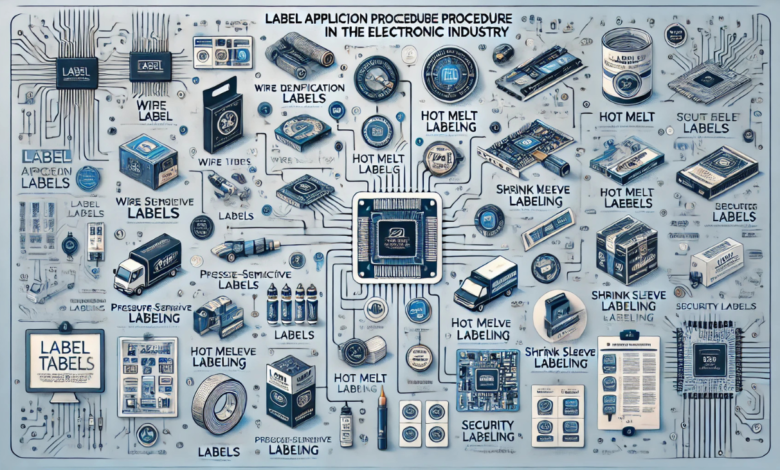Label Application Procedure Electronic Industry

In the electronic industry, proper labeling is an essential part of product manufacturing and assembly. The label application procedure electronic industry refers to the series of steps and techniques used to apply labels to components and products, ensuring they are properly identified, branded, and protected. These labels can serve a wide range of functions, from providing vital product information to offering safety precautions or serving as tamper-evident seals. In this post, we’ll explore the different types of labels, application methods, and the critical factors involved in applying labels to electronic products.
Understanding the Importance of Labeling in the Electronics Sector
The label application procedure electronic industry is not just about sticking a label on a product. It involves selecting the appropriate labels that can withstand the harsh environments to which electronic products are exposed. From circuit boards to delicate microprocessors, labels help ensure that components are traceable, safe to use, and compliant with industry standards.
Labels in the electronics industry can serve a variety of purposes, including:
- Product Identification: Labels may feature barcodes, serial numbers, and QR codes, which are essential for inventory management and product tracking.
- Branding: Visual branding labels include company logos and product details, enhancing the aesthetic appeal of consumer products.
- Regulatory Compliance: Labels often need to comply with environmental and safety regulations such as RoHS (Restriction of Hazardous Substances) or WEEE (Waste Electrical and Electronic Equipment Directive).
- Protection and Safety: Specialized labels, such as those for PCB (Printed Circuit Board) or wire identification, provide warnings or handle the physical protection of sensitive parts.
Label Types Commonly Used in Electronics
Understanding the various label types is crucial in the label application procedure electronic industry. Each label type is designed to withstand specific challenges, depending on the product’s use and environment. Some of the most common types include:
Wire Identification Labels:
These labels are used to identify wires and cables. They are designed to be durable, resistant to heat, and stable over long periods. Wire labels often use strong adhesives that withstand high temperatures and chemicals, making them ideal for components exposed to electrical environments.
PCB Labels:
Applied to circuit boards, these labels must be resistant to high temperatures and chemical reactions during the soldering process. These labels are also static dissipative, which protects sensitive electronic components from electrostatic discharge (ESD).
Branding and Product Information Labels:
These are often custom printed with logos, model numbers, and other critical product information. These labels are designed for visual appeal, ensuring they maintain clarity and durability under conditions like high heat or prolonged exposure to UV light.
Security and Tamper-Evident Labels:
In industries where counterfeit products are a concern, security labels serve to protect the integrity of the product. These labels often feature holograms, serial numbers, or other tamper-evident elements that alert consumers or manufacturers to unauthorized alterations.
The Application Process: How Labels are Affixed
The label application procedure electronic industry involves multiple steps to ensure labels adhere properly and last for the expected lifespan of the product. The methods of application vary based on the type of product and label material.
- Pressure-Sensitive Labeling: This method is one of the most common in the electronics industry. Pressure-sensitive labels adhere to surfaces when pressure is applied, and they are used on various materials like plastic, metal, and glass. The benefit of this method is that it is quick and cost-effective, making it ideal for high-volume production environments.
- Hot Melt Labeling: For products that are exposed to high temperatures or need extra durability, hot melt adhesives are often used. This method involves heating the adhesive to a molten state and applying it to the label, ensuring a strong bond that withstands environmental stress.
- Shrink Sleeve Labeling: Shrink sleeves are used for irregularly shaped components or when a tight fit is required. Once applied, heat is used to shrink the sleeve, ensuring it fits perfectly around the product. This type of labeling is often used for packaging electronic products, especially consumer electronics like phones or laptops.
- Laser Printing and Thermal Transfer: These printing techniques are employed to create high-quality, durable labels. Laser printing uses a laser to transfer toner onto a label, while thermal transfer uses heat to apply ink onto the label material. Both techniques are excellent for creating barcodes, serial numbers, and other printed information.
Key Factors in the Label Application Procedure
When applying labels in the electronics industry, there are several crucial factors to consider that ensure the labels remain effective over time. These include:
- Durability: Labels must be resistant to the harsh conditions of the electronic environment. For example, components that come into contact with solvents, oils, or extreme heat require labels made from durable materials that won’t break down or peel off easily.
- Adhesive Strength: The adhesive used in labels must be strong enough to withstand environmental factors like temperature changes and exposure to chemicals. Specially formulated adhesives are designed to remain secure even under challenging conditions like high humidity or exposure to cleaning agents.
- Compliance: Labels must meet industry standards for safety and environmental impact. This includes using materials that are RoHS-compliant (free from hazardous substances), and ensuring the labeling process adheres to regulations like WEEE or UL certifications.
- Aesthetic Appeal: Especially in consumer-facing products, the design and clarity of the label are crucial. Labels must be legible, visually appealing, and clear, even after exposure to the elements.
Conclusion
The label application procedure electronic industry is a critical part of the manufacturing process, ensuring that electronic products are identifiable, safe, and compliant with regulations. By understanding the various types of labels, the best application methods, and the essential factors that affect labeling quality, manufacturers can improve their product’s durability, traceability, and consumer appeal. Whether applying wire identification labels or branding components, getting the procedure right is crucial for maintaining the integrity and functionality of the product in the competitive electronics market.



